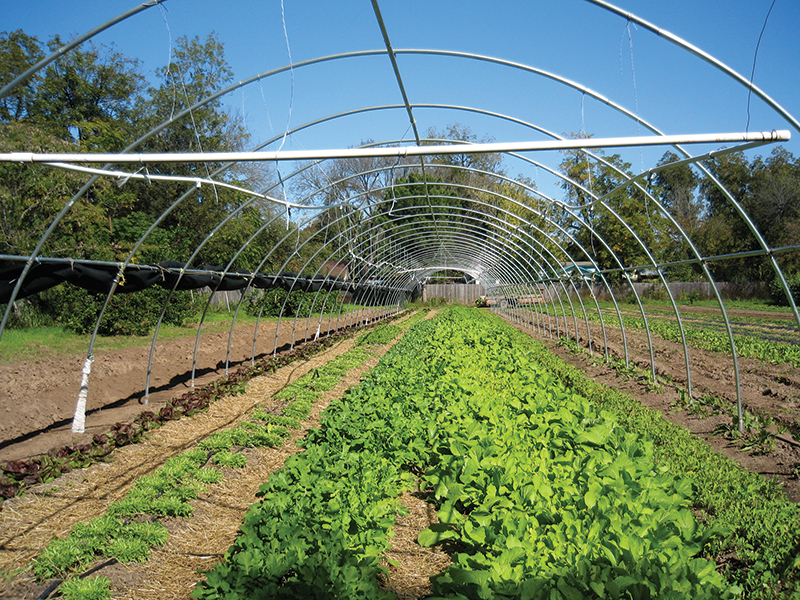
The concept of season extension always sounds nice, and when you finally get a hoop house, you realize what a value it is. Growing food sooner in the spring and later into the fall—maybe even through the winter—is more work but even more reward. When it’s hot enough to grow your crops outdoors, it might seem too hot inside to do anything useful, though, so the question becomes: “What do I do with this hoop house in the summer?”
This isn’t the case, of course, as Pam Dawling told a standing-room-only group at the Organic Growers School Spring Conference earlier this year. Dawling, author of Sustainable Market Farming (2013), takes part in making enough organic produce for everyone at the 100-person Twin Oaks Community in Louisa, Virginia, with 3½ acres and one hoop house. She offers the following ideas to make the most of your covered space year-round.
Remove The Plastic

Pulling plastic can be a pain, but for farmers with no space to spare, removing the plastic opens that area for typical gardening activity. Removing the plastic also allows rains to rebalance the salt content in the soil, which can build up under cover.
Increase Airflow
Add vents and fans at each end, and convert the hoop house sides to roll up.
Install Cooler Plastics

Different greenhouse plastics diffuse light in different ways. Some plastics, including a clear bubble film—think bubble wrap—can keep your hoop house 10 degrees cooler than others.
Use Shade Cloth
Used properly, shade cloth can make it cooler inside your greenhouse than it is outside. At Twin Oaks Community, it takes four people about one hour to put on a shade cloth and 30 to 40 minutes to take it off. “You can grow very fast-growing cool-weather crops under shade cloth,” Dawling says. This might be lettuce mix, arugula, baby kale, salad radishes or mustard greens.
Your shade cloth should cover the whole hoop house lengthwise but likely will not cover it from side to side. Pull the shade cloth all the way down the south side of the structure, as that’s where most of the sun is coming in, and worry less about the less-sunny north side.
Dawling suggests a knitted, non-PVC shade cloth with a 40-percent shade for vegetables, 50 percent for flowers and 60 percent for cool-weather vegetables in hot weather. A heavier shade cloth—80 percent—makes a hoop house an ideal place for curing and drying your harvest, too.
Grow Warm-Weather Vegetables
Dawling goes for crops they’d like to have earlier—tomatoes, peppers, etc.—for a first planting in the spring and crops that grow in warmer climates—baby ginger, turmeric, jicama—for a subsequent summer planting. Also, crops that grow better in drier climates make sense, as you have control over the amount of water your high-tunnel plants receive, unlike Mother Nature’s watering schedule.
Grow Seed Crops
If you want to save seeds, growing crops in an under-plastic environment could force them to seed faster. Dawson lists beans, peas, okra, overwintered brassicas, lettuce, beets and chard as options.
Grow Cover Crops
“You can help to improve the organic matter in your soil, and if you’re unfortunate enough to have weeds in there, you can help deal with those,” Dawling says.
Grow short-term cover crops, and don’t allow them to go to seed. Brassica cover crops, such as mustard, can have a biofumigation effect on soil diseases, and legumes, such as soybeans and cowpeas, offer a nitrogen boost to your soil.
Pair a brassica cover crop with soil solarization to combat fungal soil diseases and nematodes. Till the cover crop when it flowers, and prep your beds for the next crop you plan to grow. Cover the soil inside the hoop house with plastic, and close up the structure for four to eight weeks during the hottest weather. “It’s just killing off the stuff near the surface,” Dawling says, so soil life will evacuate to about 6 inches down, but it will come back.
With all of the effort and expense that you’ve put into getting a hoop house, you deserve to get the most out of it. With some creative thinking, this structure has something to offer even during the hottest months.
This story originally appeared in the July/August issue of Hobby Farms magazine.




